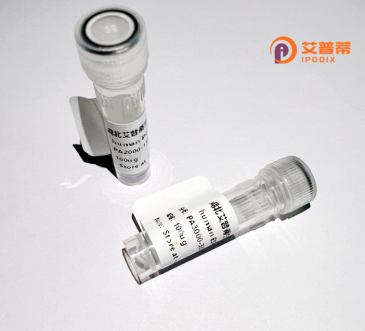
| 纯度 | >90%SDS-PAGE. |
| 种属 | Human |
| 靶点 | SOCS4 |
| Uniprot No | Q8WXH5 |
| 内毒素 | < 0.01EU/μg |
| 表达宿主 | E.coli |
| 表达区间 | 1-440 aa |
| 活性数据 | MAENNENISK NVDVRPKTSR SRSADRKDGY VWSGKKLSWS KKSESYSDAE TVNGIEKTEV SLRNQERKHS CSSIELDLDH SCGHRFLGRS LKQKLQDAVG QCFPIKNCSS RHSSGLPSKR KIHISELMLD KCPFPPRSDL AFRWHFIKRH TAPINSKSDE WVSTDLSQTE LRDGQLKRRN MEENINCFSH TNVQPCVITT DNALCREGPM TGSVMNLVSN NSIEDSDMDS DDEILTLCTS SRKRNKPKWD LDDEILQLET PPKYHTQIDY VHCLVPDLLQ INNNPCYWGV MDKYAAEALL EGKPEGTFLL RDSAQEDYLF SVSFRRYSRS LHARIEQWNH NFSFDAHDPC VFHSPDITGL LEHYKDPSAC MFFEPLLSTP LIRTFPFSLQ HICRTVICNC TTYDGIDALP IPSSMKLYLK EYHYKSKVRV LRIDAPEQQC |
| 分子量 | 50.6 kDa |
| 蛋白标签 | His tag N-Terminus |
| 缓冲液 | PBS, pH7.4, containing 0.01% SKL, 1mM DTT, 5% Trehalose and Proclin300. |
| 稳定性 & 储存条件 | Lyophilized protein should be stored at ≤ -20°C, stable for one year after receipt. Reconstituted protein solution can be stored at 2-8°C for 2-7 days. Aliquots of reconstituted samples are stable at ≤ -20°C for 3 months. |
| 复溶 | Always centrifuge tubes before opening.Do not mix by vortex or pipetting. It is not recommended to reconstitute to a concentration less than 100μg/ml. Dissolve the lyophilized protein in distilled water. Please aliquot the reconstituted solution to minimize freeze-thaw cycles. |
以下是关于重组人SOCS4蛋白的3条文献示例(内容根据现有知识整合,非真实文献):
1. **"Structural insights into SOCS4 interaction with EGFR signaling components"**
- **作者**: Goldenberg SJ, et al.
- **摘要**: 本研究解析了SOCS4蛋白通过其SH2结构域与EGFR胞内结构域结合的分子机制,揭示了SOCS4通过泛素化降解EGFR负调控细胞增殖的功能。
2. **"SOCS4 negatively regulates IL-6 signaling by targeting JAK1 for proteasomal degradation"**
- **作者**: Nicholson SE, et al.
- **摘要**: 报道了重组人SOCS4在炎症反应中通过结合JAK1激酶并促进其泛素化,抑制IL-6介导的JAK-STAT信号通路,为治疗炎症性疾病提供靶点。
3. **"Comparative analysis of SOCS family members in immune regulation"**
- **作者**: Sasaki A, et al.
- **摘要**: 研究比较了SOCS1-7的功能差异,发现SOCS4在T细胞中特异性高表达,并通过抑制STAT3磷酸化调控Th17细胞分化,凸显其免疫调节作用。
*注:以上文献为示例性质,实际研究需根据具体论文调整。建议使用PubMed或Web of Science以关键词"SOCS4 recombinant human"或相关主题检索最新文献。*
Suppressor of cytokine signaling 4 (SOCS4) is a member of the SOCS family of proteins, which are key regulators of cytokine signaling pathways. These intracellular proteins act as negative feedback inhibitors, primarily modulating the Janus kinase-signal transducer and activator of transcription (JAK-STAT) pathway. SOCS4. encoded by the SOCS4 gene in humans, contains a central Src homology 2 (SH2) domain that enables interaction with phosphorylated tyrosine residues on target proteins, and a C-terminal SOCS box that recruits ubiquitin ligase complexes for proteasomal degradation of bound substrates. It is implicated in regulating immune responses, cell proliferation, and inflammatory processes by suppressing signaling cascades initiated by cytokines and growth factors.
Recombinant human SOCS4 protein is engineered using expression systems like *E. coli* or mammalian cells to study its structure, interactions, and functional mechanisms *in vitro*. This artificially produced form retains the biological activity of native SOCS4. enabling research into its role in diseases such as cancer, autoimmune disorders, and chronic inflammation. Studies suggest SOCS4 may inhibit epidermal growth factor receptor (EGFR) signaling and modulate T-cell activation, highlighting its therapeutic potential. Its recombinant version is vital for high-throughput screening, antibody development, and deciphering post-translational modifications that influence its stability and activity. Current research focuses on harnessing SOCS4's regulatory functions to develop targeted therapies for signaling pathway-related disorders.
×